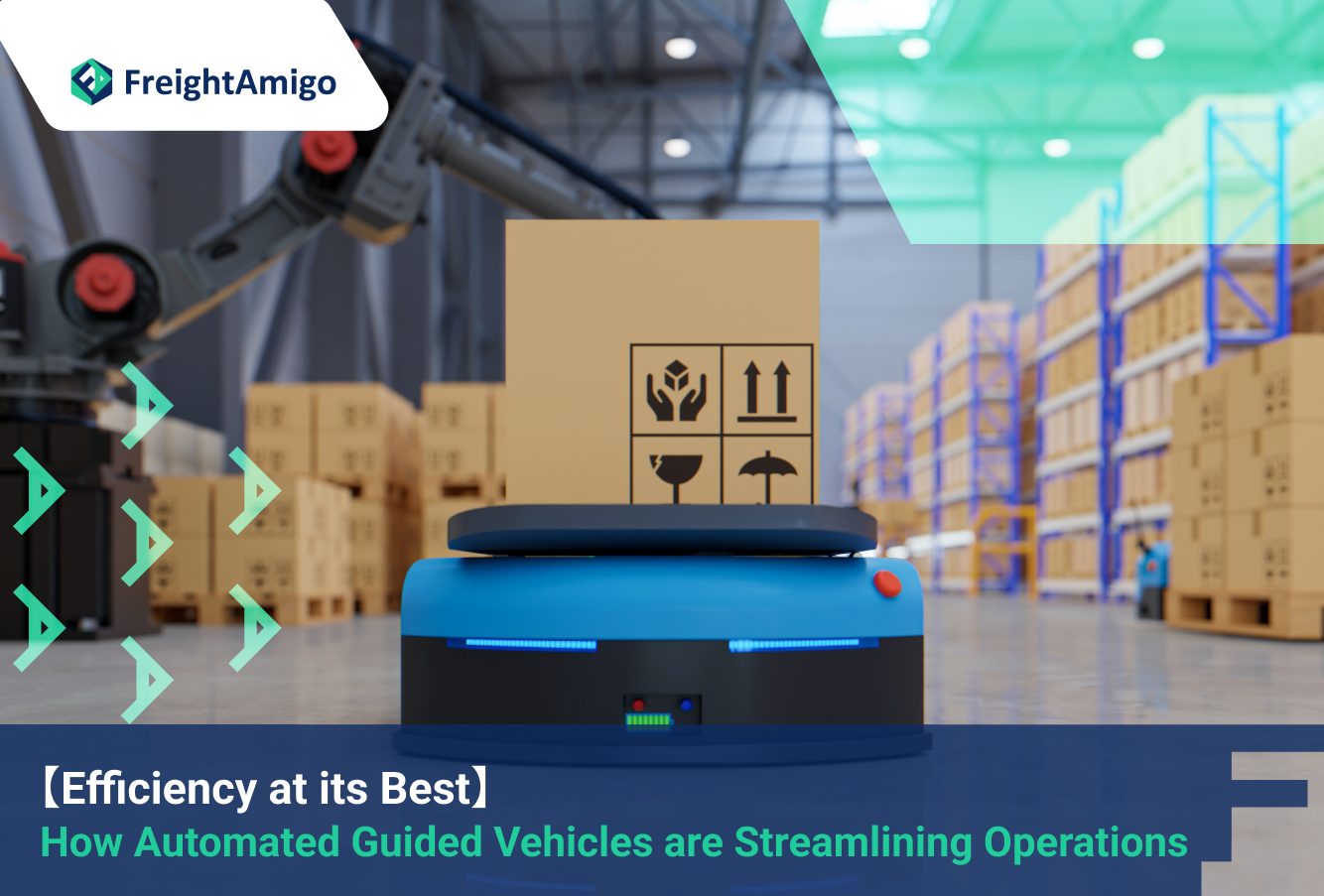30th January, 2024: Caspian Ng– Marketing Analyst at FreightAmigo
Introduction to Automated Guided Vehicles (AGVs)
In today’s fast-paced world, businesses are constantly seeking ways to optimize their operations and increase efficiency. One remarkable solution that has gained tremendous popularity in recent years is the use of Automated Guided Vehicles (AGVs) in warehouse operations. AGVs are a type of robotic vehicle that can navigate and perform tasks without the need for human intervention. These intelligent machines have revolutionized the way warehouses operate, offering a multitude of benefits that contribute to streamlined and efficient operations.
Want To Compare The Best Express, Air Freight, Sea Freight, Rail Freight & Trucking Rates So As To Have Better Control On Cost?
Benefits of Using Automated Guided Vehicles in Warehouse Operations
The implementation of AGVs in warehouse operations brings forth a wide range of benefits that have a significant impact on overall efficiency. Firstly, AGVs eliminate the need for manual labor in repetitive tasks such as material handling and transportation. By automating these processes, businesses can reduce labor costs while increasing productivity. AGVs also operate with precision and accuracy, minimizing the risk of errors that may occur with human intervention. This not only leads to a decrease in product damage but also enhances the overall quality of operations.
Another notable advantage of AGVs is their ability to optimize space utilization within warehouses. These vehicles are designed to navigate through narrow aisles and tight spaces, allowing for efficient use of available storage areas. By maximizing storage capacity, businesses can reduce the need for additional warehouse space, resulting in significant cost savings.
Furthermore, AGVs can be programmed to operate 24/7, enabling round-the-clock operations without the need for breaks or shift changes. This non-stop workflow ensures a continuous flow of goods, reducing downtime and increasing overall productivity. AGVs also contribute to a safer work environment by minimizing the risk of accidents and injuries that may occur due to human error. With their advanced sensors and collision avoidance systems, AGVs can navigate through the warehouse with precision, ensuring the safety of both the machines and the employees.
Types of Automated Guided Vehicles (AGVs)
AGVs come in various types, each specifically designed to cater to different warehouse requirements. One common type is the forklift AGV, which is equipped with forks to lift and transport pallets or containers. These vehicles are ideal for material handling tasks, such as loading and unloading goods from shelves or trucks.
Another type of AGV is the tugger AGV, which can tow multiple carts or trailers behind it. Tugger AGVs are commonly used in industries where goods need to be transported in batches or where assembly lines are involved. They offer a flexible and efficient solution for moving materials within the warehouse, reducing the need for manual labor and improving overall productivity.
Conveyor AGVs are another popular type, which are designed to transport goods along a fixed path. These AGVs are equipped with conveyor belts or rollers, allowing for seamless transportation of products from one location to another. They are often used in manufacturing facilities or distribution centers where a continuous flow of goods is required.
How Automated Guided Vehicles are Streamlining Operations in Warehouses
The integration of AGVs into warehouse operations has proven to be a game-changer. These intelligent machines are capable of performing tasks with speed and precision, significantly streamlining operations. One key area where AGVs excel is in material handling. AGVs can autonomously transport goods from one location to another, eliminating the need for manual labor and reducing the time required for these tasks. This not only increases efficiency but also allows employees to focus on more complex and value-added activities.
AGVs also contribute to efficient inventory management. With their advanced sensors and tracking systems, these vehicles can accurately locate and retrieve items from the warehouse shelves. They can be programmed to follow a predetermined path, ensuring that no time is wasted in searching for specific products. This level of automation not only saves time but also minimizes the risk of errors in inventory management, leading to improved accuracy and customer satisfaction.
Additionally, AGVs are capable of working in synchronization with other automated systems, such as conveyor belts or robotic arms. This seamless integration allows for a continuous flow of goods within the warehouse, minimizing bottlenecks and optimizing overall throughput. By eliminating the need for manual intervention in these processes, businesses can achieve higher levels of efficiency and productivity.
Considerations for Selecting the Right Automated Guided Vehicles for Your Operations
When choosing AGVs for warehouse operations, several factors need to be taken into consideration. Firstly, it is essential to assess the specific requirements of the warehouse. This includes evaluating the types of tasks that need to be automated, the layout of the warehouse, and the volume of goods to be handled. By understanding these requirements, businesses can select AGVs that are best suited for their operations.
Another crucial consideration is the compatibility of AGVs with existing systems and equipment within the warehouse. AGVs should seamlessly integrate with other automated systems, such as conveyor belts or warehouse management software, to ensure a smooth workflow. It is also important to consider the scalability of AGVs. As business needs evolve, the AGV fleet should be able to accommodate future growth and changes in operations.
Lastly, businesses should carefully evaluate the reliability and support provided by AGV manufacturers. It is crucial to choose reputable manufacturers that offer reliable products and comprehensive after-sales support. This ensures that any technical issues or maintenance requirements can be promptly addressed, minimizing downtime and maximizing the efficiency of AGVs in warehouse operations.
Future Trends and Advancements in Automated Guided Vehicle Technology
The future of AGVs looks promising, with continuous advancements in technology driving innovation in this field. One notable trend is the integration of artificial intelligence and machine learning capabilities into AGVs. This enables the vehicles to learn from their surroundings and make intelligent decisions, further enhancing their autonomy and adaptability.
Another exciting advancement is the development of swarm robotics, where multiple AGVs collaborate and communicate with each other to achieve complex tasks. This swarm intelligence allows for greater coordination and flexibility in warehouse operations, leading to increased efficiency and productivity.
Furthermore, the use of advanced sensors and cameras in AGVs is expected to become more prevalent. These sensors can provide real-time data on the warehouse environment, allowing AGVs to make quick and informed decisions. This enhanced perception and situational awareness will contribute to safer and more efficient operations.
Conclusion: The Future of Efficiency with Automated Guided Vehicles
As technology continues to evolve, AGVs are set to play a crucial role in streamlining warehouse operations. The benefits they offer, such as reduced labor costs, increased productivity, and optimized space utilization, make them an attractive solution for businesses seeking to improve efficiency. While challenges and limitations exist, continuous advancements in AGV technology are addressing these issues and paving the way for a more automated and efficient future.
With their ability to perform tasks with speed, precision, and reliability, AGVs are revolutionizing the way warehouses operate. By selecting the right AGVs for their operations and considering factors such as requirements, compatibility, and support, businesses can harness the true power of automation. As the future unfolds, AGVs will continue to evolve, becoming smarter, more capable, and more integrated with other automated systems. Embracing this technology will undoubtedly pave the way for a future where efficiency is at its best.
There Are Different Options For Cargo Transportation. If You Want To Choose The Most Convenient And Suitable Solution, It Is Best To Have The Full Support Of Logistics Experts! If You Are Planning To Ship Goods Overseas, Please Go To The FreightAmigo Page For Inquiries.
===
Read More:
【E-commerce Dropshipping】 The Ultimate Guide to Starting Your Own Online Store
【International E-commerce and Shipping】 Ultimate Guide to Shipping to Japan for E-commerce Business
【Shipping to South Korea】 A Comprehensive Guide for Ecommerce Business
If you have any inquiries on logistics/supply chain, feel free to contact FreightAmigo now:
Chat with us online | Hotline: +852 28121686 | WhatsApp: +852 27467829



